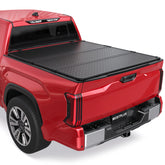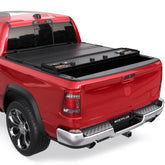Car shocks: operation and maintenance
If you feel that your vehicle's road holding, traction and comfort are suffering, it may be time to check the wear and tear on your shocks. MOSTPLUS explains how shocks work and how to maintain them:
What are shocks?
Shock absorbers are part of a vehicle's suspension system that maintains contact between the wheels and the road. Together with the suspension springs, they are essential components for optimum driving comfort and safety.
When the wheels hit potholes or bumps in the road, there is an impact that reverberates through the vehicle. The suspension system uses springs to limit the force of this impact. The role of the shock absorbers is to absorb the rebound effect created as the energy passes through the springs, stabilizing the wheels and preventing interior vibration.
There are two types of shock absorbers: hydraulic shock absorbers and gas shock absorbers.
- The hydraulic shock absorber has a piston that moves inside a tube. The tube consists of two chambers, one containing oil and the other air. Each time the vehicle moves, the piston is pushed into the tube and displaces the oil in the air chamber. The compression of the air creates a drag force that helps slow the energy of the rebound.
- Gas shocks work similarly, but use nitrogen to make the piston more responsive and therefore more efficient. This system is also more expensive than the hydraulic shock.
The shock absorber is inseparable from the damper: also known as the shock absorber head, this part forms the upper part of the shock absorber rod. It is attached to the car body and consists of three separate parts:
- A rubber bumper that absorbs shocks and dampens vibrations;
- A round metal fitting with three screws that attaches the damper to the body;
- A bearing ring that synchronizes the rotation of the wheels with that of the spring/shock assembly.
On average, the cup is subjected to approximately 1 million rotations every 80,000 km.

Why service your shocks?
Shock absorbers have a direct impact on the quality of your vehicle's braking and steering, as they ensure optimum road contact during braking and cornering.
Your car's road-holding ability is closely related to the condition of your shocks, because when they are worn, the shocks limit the grip of the wheels on the road.
Well-maintained shocks provide optimal ride comfort and safety. Worn shocks, on the other hand, pose great risks:
- Your vehicle is more susceptible to spinning and aquaplaning;
- Steering is less precise and road holding is reduced;
- Shock absorption is less effective;
- Fuel consumption increases;
- Braking distance increases (up to 6 meters further on wet surfaces);
- Tires and suspension components wear faster.
- It's also important to note that the less effectively the vehicle is cushioned, the less comfortable the ride will be for passengers and driver. What's more, the driver will tire more quickly.

Whether you expect it or not, you are going to have to replace your shock absorbers, if for no other reason than to pass your vehicle inspection. But risks aside, maintaining your vehicle's suspension system will give you real ride comfort and precise steering that will take the strain off you on long trips.
What are the signs of a worn shock absorber?
When you're driving, your shocks are under constant stress, so they gradually deteriorate. The effects of worn shocks on your vehicle's handling will also be gradual. It's quite possible that you won't notice: you'll adapt your driving style to these new conditions without even realizing it.
However, there are a few signs that your shocks are wearing out:
- Your vehicle requires a longer stopping distance;
- You have a hard time keeping your vehicle under control in curves;
- You notice abnormal steering wheel vibration;
- Your tires wear faster and more irregularly;
- Your vehicle is less stable at high speeds;
- You feel your wheels lose grip when accelerating;
- Your shock absorber leaks oil;
- Your shocks "rattle" when you drive over a speed bump.
These signs are not always easy to interpret: often the problem can also be due to poor vehicle alignment or a steering problem. When in doubt, it's best to contact your service center.
It may also be a good idea to perform a simple visual inspection of your shock absorbers on a regular basis: a leak, corrosion or even a crack in the shock absorbers is easily visible to the naked eye.

When should you replace your shocks?
To prevent your shocks from wearing out, we recommend that you have them checked every year or every 20,000 km to see how they're doing. On average, shocks should be replaced every 80,000 km, but this may vary depending on your use.
A smooth ride will extend the life of your shocks. On the other hand, avoid poorly maintained roads whenever possible! Driving your car over bumps and undulations puts great stress on the shock absorbers in order to reduce the impact on the wheels, suspension, steering and interior.
Driving mainly in urban areas tends to accelerate the wear and tear of the shocks, which are subjected to stress during braking.
A vehicle that is systematically loaded (roof rack, tow bar, trailer, etc.) also causes the shocks to wear more quickly.
Finally, be aware that extreme temperatures (both very high and very low) and the presence of mud, dust or salt water on the road (risk of corrosion) can also accelerate the wear of your shocks.
How to change your shocks?
You should always replace the complete shock set (spring and shock), whether the problem is with the stopper, the metal fitting or the bearing ring. Shocks should always be replaced in pairs to maintain the proper balance of your vehicle.
It's also a good idea to replace the shock absorber cups every time you replace the shocks. A worn shock cup will cause rattling or squealing noises and premature wear to the wheels and suspension system. Replacing the cup will add to the price of the service, but it will save you from paying a lot more when you have to replace the parts damaged by the worn cup.

Which shock absorber should you choose for your car?
The choice of shock absorber is crucial: your safety, comfort and the longevity of the parts connected to the suspension depend on its quality. Don't be afraid to pay a little more for a better quality shock that will wear out less quickly and require less frequent replacement (and therefore less maintenance).
You should choose a shock of the same quality and firmness as your original shocks. This will prevent damage to the suspension system, which is designed to adapt to a specific type of shock.
Note that the quality of a shock does not depend on the brand! You don't have to buy the same brand of shocks as the original ones: in fact, for each vehicle, several manufacturers offer models that meet the manufacturer's recommendations.
Last but not least, remember that pneumatic dampers are more expensive but more effective than hydraulic dampers. They offer greater responsiveness, better road holding and shorter stopping distances.
Featured Products
- $479.99
$499.99- $479.99
- Unit price
- / per
- $549.99
$549.99- $549.99
- Unit price
- / per
- $489.99
- $489.99
- Unit price
- / per
- $469.99
$489.67- $469.99
- Unit price
- / per














